Subjective Evaluation on the Annoyance of Environmental Noise Containing Low-Frequency Tonal Components
Abstract
1. Introduction
- Psychological responses to noise, including low-frequency tones of below 100 Hz.
- Psychological responses to situations with low test background noise levels.
1.1. Laboratory Annoyance
1.2. Study Outline
2. Method
2.1. Experimental System
2.2. Test Stimuli
2.3. Procedure
2.4. Statistical Analysis
3. Results
3.1. Relationships between Annoyance and TA
3.2. Relationships between Annoyance and A-Weighted Sound Pressure Level
3.3. Quantification of the Increase of Annoyance Owing to Tonal Components
3.3.1. Calculation of Tonal Adjustment
3.3.2. Tonal Adjustment Obtained from the Experiment
4. Discussion
4.1. Comparison with Guidelines for Noise Evaluation
4.2. Comparison with Previous Studies
4.3. Limitations
5. Conclusions
- The addition of the tonal component increased the annoyance. The amount of increase depended on the tonal level, tonal frequency, and the level of the background noise. The increase in annoyance was greater when the background noise was quiet (25 and 30 dB). The higher the tonal frequency is, the higher the annoyance.
- The increase in annoyance owing to the tonal component was quantified and expressed as tonal adjustment ΔL. The tonal adjustment values were 0–7 dB for the 25 and 30 dB conditions (bedtime) and 0–5 dB for the 35 dB condition (daytime), which is comparable to the correction value k given in ISO1996-2:2017.
- As a feature of the low-frequency range, the annoyance tended to be lower when the overall noise level was low. This may be due to the fact that it is difficult to hear the tone when the energy of the tonal component is close to the absolute threshold of hearing, even if the TA, which is the relative energy ratio of pure tone and noise, is the same.
Author Contributions
Funding
Institutional Review Board Statement
Informed Consent Statement
Data Availability Statement
Acknowledgments
Conflicts of Interest
References
- ISO/PAS 20065:2016. Acoustics—Objective Method for Assessing the Audibility of Tones in Noise—Engineering Method; ISO: Geneva, Switzerland, 2016. [Google Scholar]
- IEC 61400-11:2012. Wind Turbines–Part 11: Acoustic Noise Measurement Techniques; IEC: Geneva, Switzerland, 2012. [Google Scholar]
- ISO 1996-2:2017. Acoustics—Description, Measurement and Assessment of Environmental Noise—Part 2: Determination of Sound Pressure Levels; ISO: Geneva, Switzerland, 2017. [Google Scholar]
- Fowler, K.; Koppen, E.; Matthis, K. Noise International Legislation and Regulations for Wind Turbine Noise. In Proceedings of the 5th International Meeting on Wind Turbine Noise, Denver, CO, USA, 28–30 August 2013. [Google Scholar]
- Ministry of the Environment, Government of Japan. Manual for the Measurement of Noise Generated by Wind Farms; Ministry of the Environment, Government of Japan: Tokyo, Japan, 2017. (In Japanese)
- Yokoyama, S.; Kobayashi, T.; Tachibana, H. Perception of tonal components contained in wind turbine noise. In Proceedings of the Inter-Noise 2016, Hamburg, Germany, 21–24 August 2016; pp. 2628–2639. [Google Scholar]
- Pedersen, E.; Waye, K.P. Perception and annoyance due to wind turbine noise—A dose–response relationship. J. Acoust. Soc. Am. 2004, 116, 3460–3470. [Google Scholar] [CrossRef] [PubMed]
- Pedersen, E.; Waye, K.P. Wind turbine noise, annoyance and self-reported health and well-being in different living environments. Occup. Environ. Med. 2007, 64, 480–486. [Google Scholar] [CrossRef] [PubMed]
- Janssen, S.A.; Vos, H.; Eisses, A.R.; Pedersen, E. A comparison between exposure-response relationships for wind turbine annoyance and annoyance due to other noise sources. J. Acoust. Soc. Am. 2011, 130, 3746–3753. [Google Scholar] [CrossRef] [PubMed]
- Kuwano, S.; Yano, T.; Kageyama, T.; Sueoka, S.; Tachibana, H. Social survey on wind turbine noise in Japan. Noise Control Eng. J. 2014, 62, 503–520. [Google Scholar] [CrossRef]
- WHO. Environmental Noise Guidelines for the European Region; World Health Organization Regional Office for Europe: Geneva, Switzerland, 2018. [Google Scholar]
- Haac, T.R.; Kaliski, K.; Landis, M.; Hoen, B.; Rand, J.; Firestone, J.; Elliott, D.; Hübner, G.; Pohl, J. Wind turbine audibility and noise annoyance in a national U.S. survey: Individual perception and influencing factors. J. Acoust. Soc. Am. 2019, 146, 1124–1141. [Google Scholar] [CrossRef] [PubMed]
- Little, J.W. Human Response to Jet Engine Noises. Noise Control 1961, 7, 11–13. [Google Scholar] [CrossRef]
- Landström, U.; Åkerlund, E.; Kjellberg, A.; Tesarz, M. Exposure levels, tonal components, and noise annoyance in working environments. Environ. Int. 1995, 21, 265–275. [Google Scholar] [CrossRef]
- Renewable Energy Systems Ltd.; Hemel Hempstead. Objective and Subjective Rating of Tonal Noise Radiated from UK Wind Farms, ETSU-W-13-00354-44/REP; Renewable Energy Systems Ltd.: Kings Langley, UK; Hemel Hempstead: London, UK, 1996. [Google Scholar]
- Ryherd, E.E.; Wang, L.M. The effects of noise from building mechanical systems with tonal components on human performance and perception. ASHRAE Trans. 2010, 116 Pt 2, 541–552. [Google Scholar]
- Oliva, D.; Hongisto, V.; Haapakangas, A. Annoyance of low-level tonal sounds–Factors affecting the penalty. Build. Environ. 2017, 123, 404–414. [Google Scholar] [CrossRef]
- Hongisto, V.; Saarinen, P.; Oliva, D. Annoyance of low-level tonal sounds–A penalty model. Appl. Acoust. 2019, 145, 358–361. [Google Scholar] [CrossRef]
- Hansen, K.; Nguyen, P.; Zajamsek, B.; Micic, G.; Catcheside, P. Pilot study on perceived sleep acceptability of low-frequency, amplitude modulated tonal noise. In Proceedings of the International Congress on Acoustics, Aachen, Germany, 9–13 September 2019; pp. 1447–1454. [Google Scholar]
- Sato, T.; Yano, T.; Björkman, M.; Rylander, R. Comparison of community response to road traffic noise in Japan and Sweden– Part I: Outline of surveys and dose-response relationships. J. Sound Vib. 2002, 250, 161–167. [Google Scholar] [CrossRef]
- Namba, S. On the psychological measurement of loudness, noisiness and annoyance: A review. J. Acoust. Soc. Jpn. 1987, 8, 211–222. [Google Scholar] [CrossRef]
- Västfjäll, D. Influences of current mood and noise sensitivity on judgments of noise annoyance. J. Psychol. Interdiscip. Appl. 2014, 136, 357–370. [Google Scholar] [CrossRef] [PubMed]
- Sakamoto, S.; Yokoyama, S.; Yano, H.; Tachibana, H. Experimental study on hearing thresholds for low-frequency pure tones. Acoust. Sci. Technol. 2014, 35, 213–218. [Google Scholar] [CrossRef][Green Version]
- Tachibana, H.; Yano, H.; Fukushima, A.; Sueoka, S. Nationwide field measurements of wind turbine noise in Japan. Noise Control Eng. J. 2014, 62, 90–101. [Google Scholar] [CrossRef]
- Tachibana, H. Modelling of house filter for wind turbine noise. In Proceedings of the 6th International Conference on Wind Turbine Noise, Glasgow, Scotland, 20–23 April 2015. [Google Scholar]
- Brambilla, G.; Pedrielli, F. The Assessment of Tonal Components in the Environmental Noise: Features and Limitations of the Italian Legislation. In Proceedings of the Inter-Noise 96, Liverpool, UK, 30 July–2 August 1996; pp. 2531–2536. [Google Scholar]
- Hansen, H.; Weber, R. Semantic evaluations of noise with tonal components in Japan, France, and Germany: A cross-cultural comparison. J. Acoust. Soc. Am. 2009, 125, 850–862. [Google Scholar] [CrossRef] [PubMed]
- Doleschal, F.; Rottengruber, H.; Verhey, J.L. Influence parameters on the perceived magnitude of tonal content of electric vehicle interior sounds. Appl. Acoust. 2021, 181, 108155. [Google Scholar] [CrossRef]
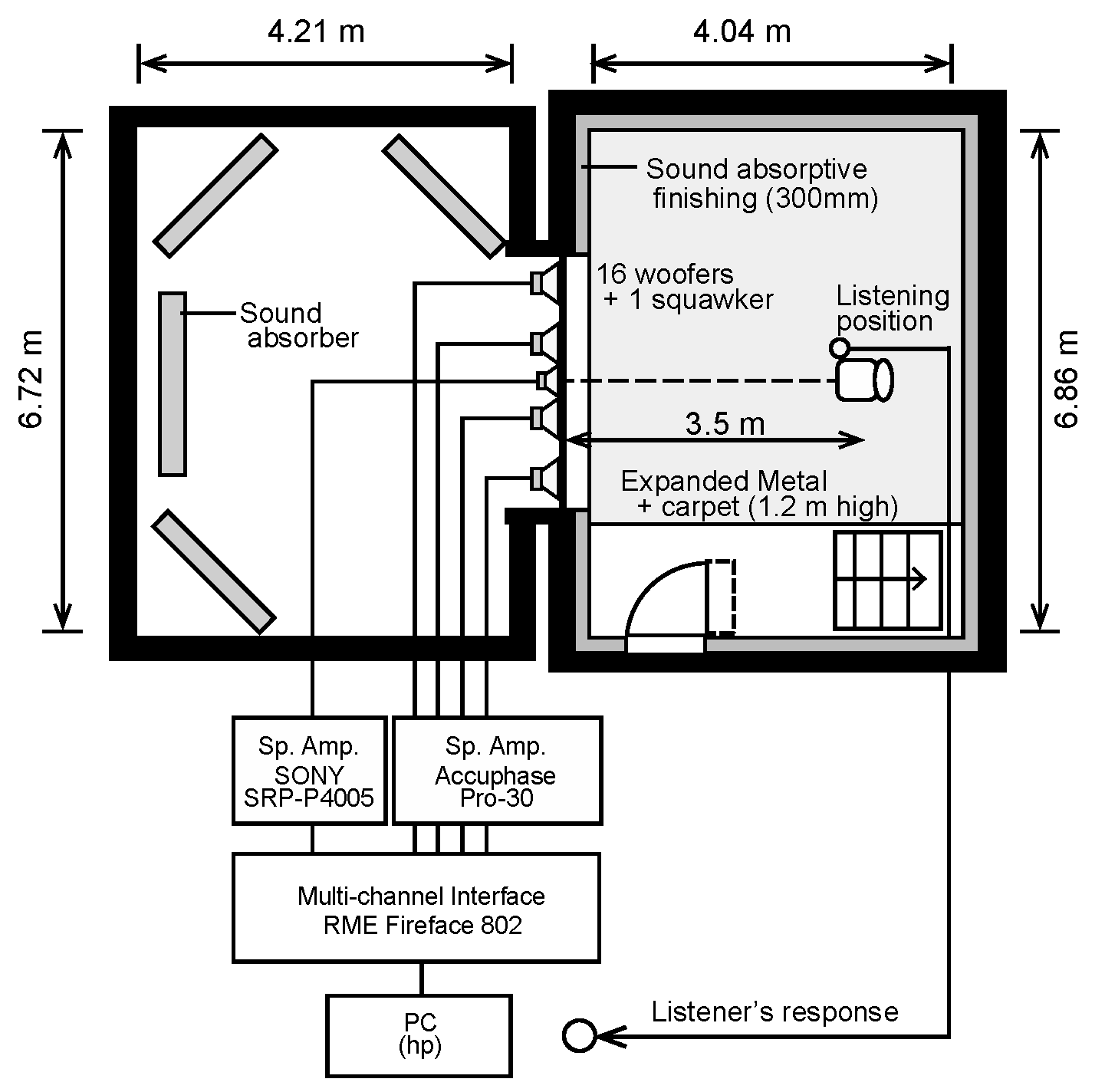
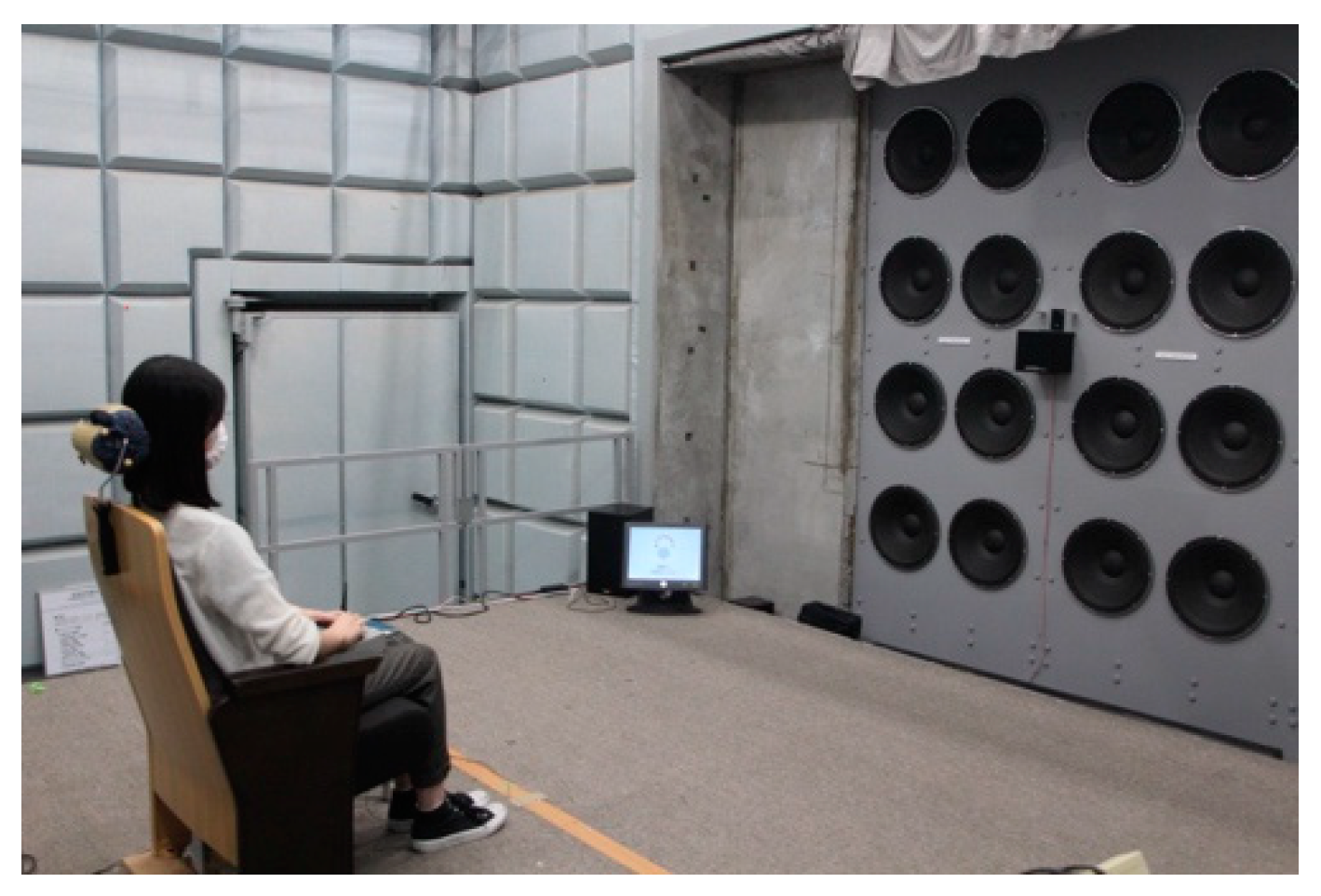
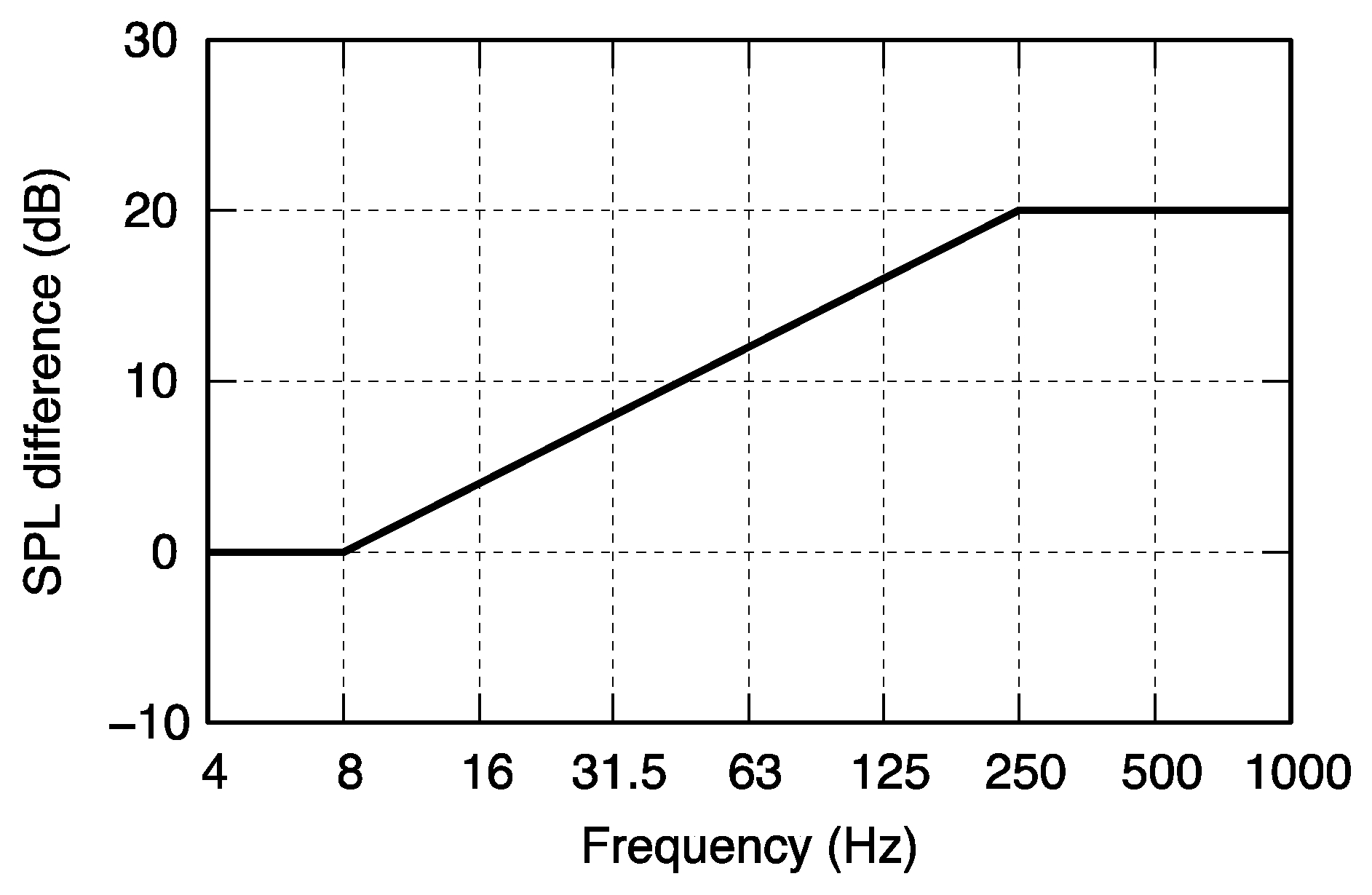
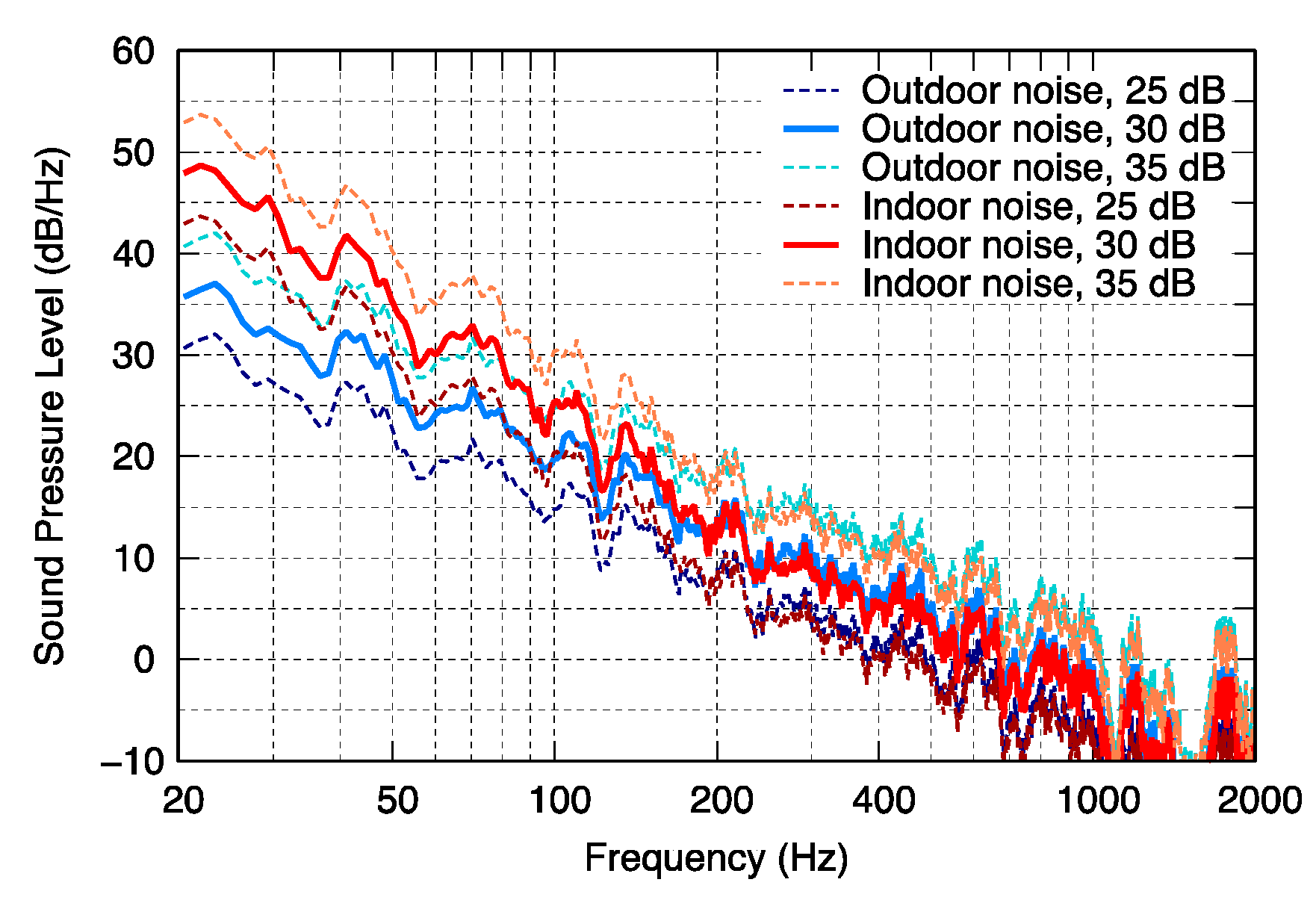
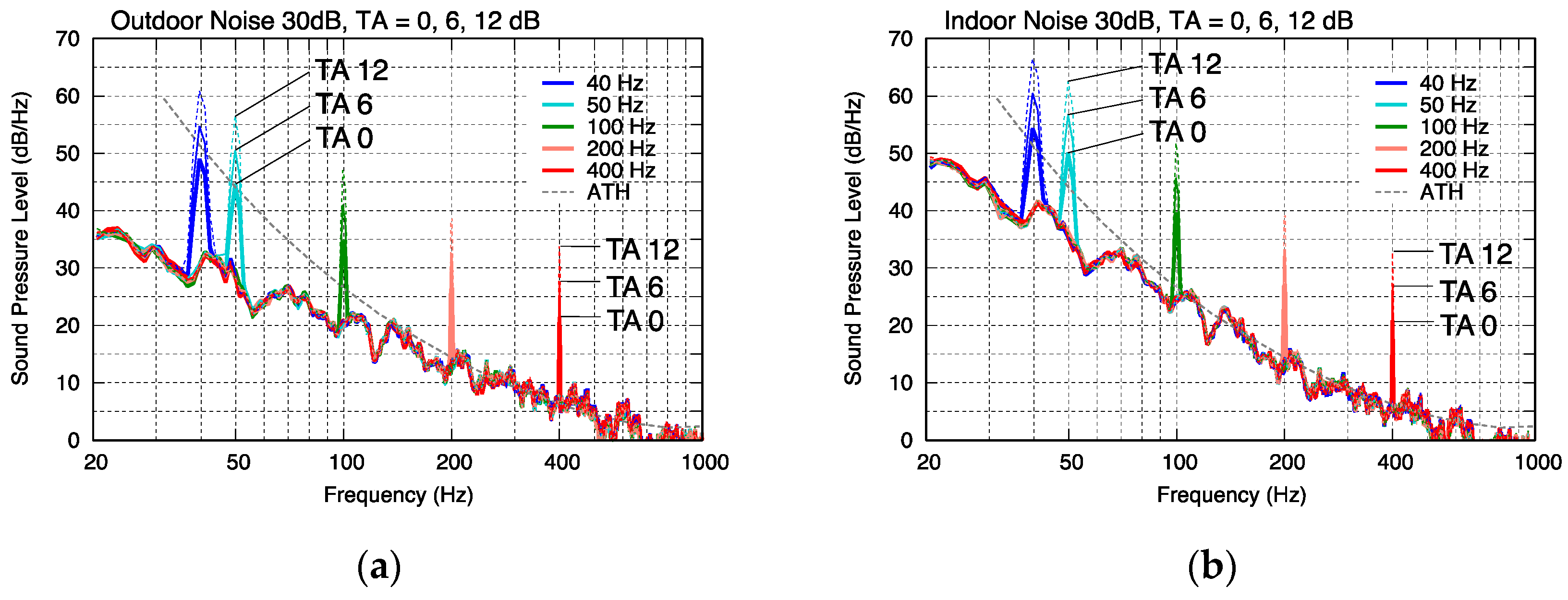
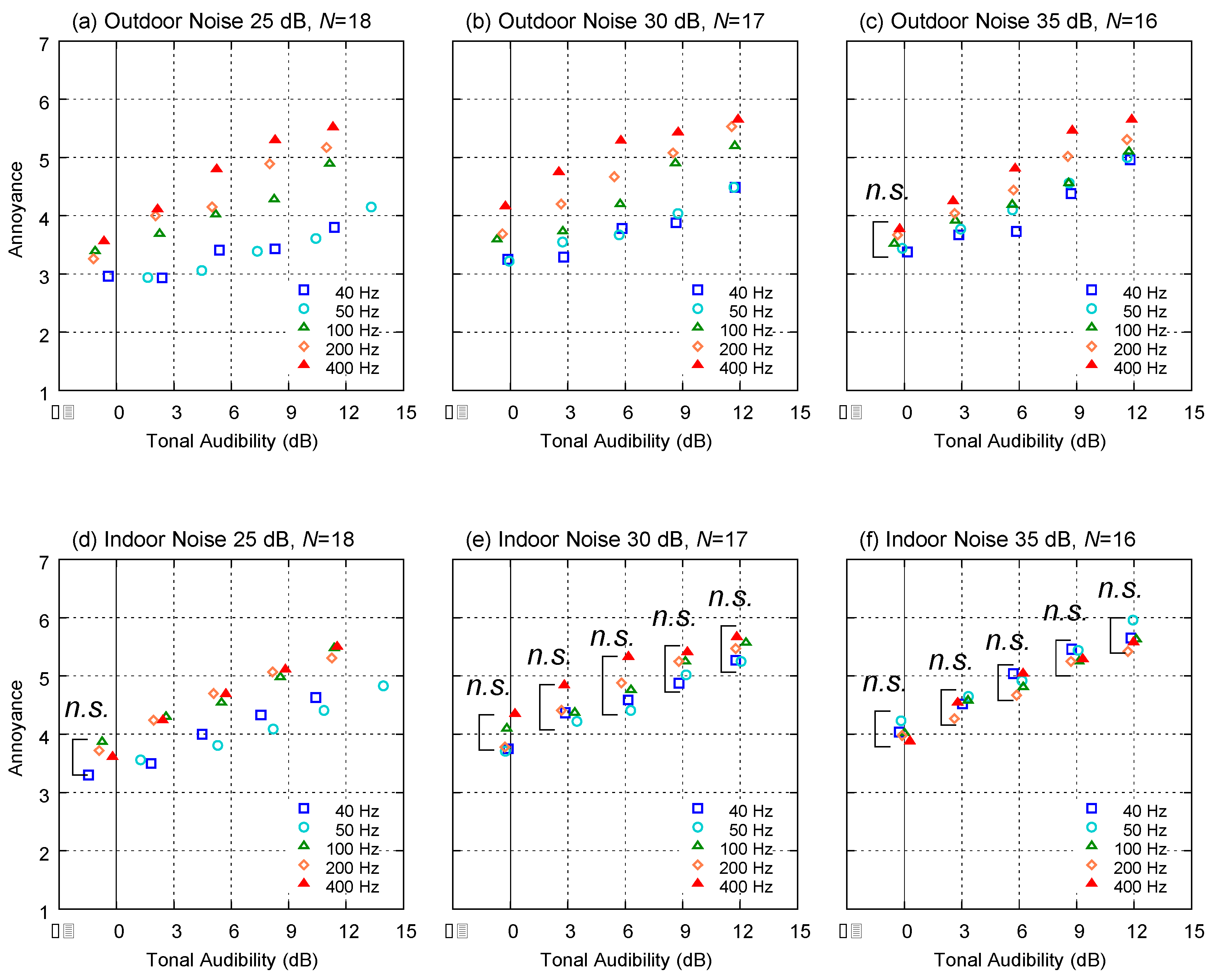

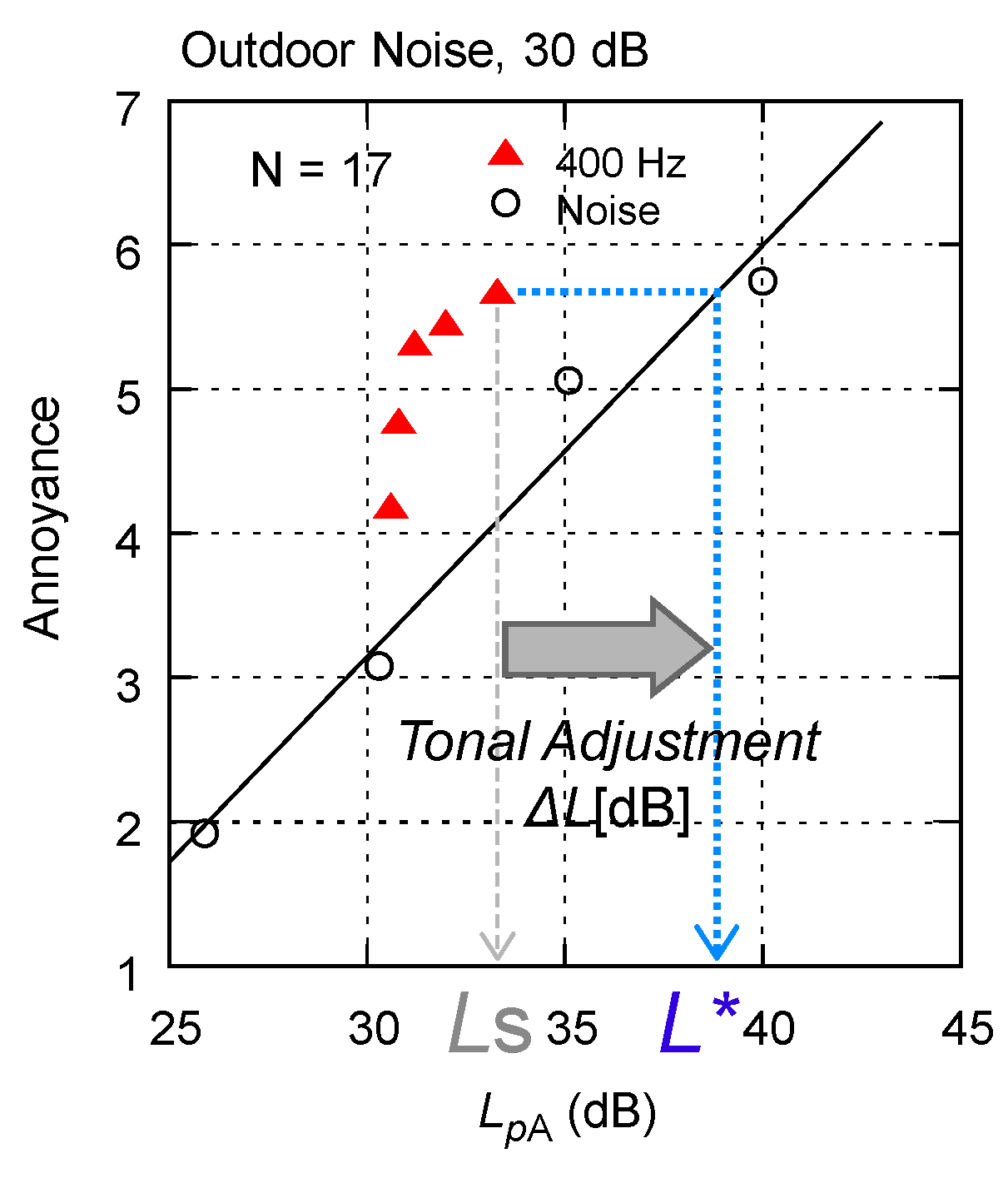
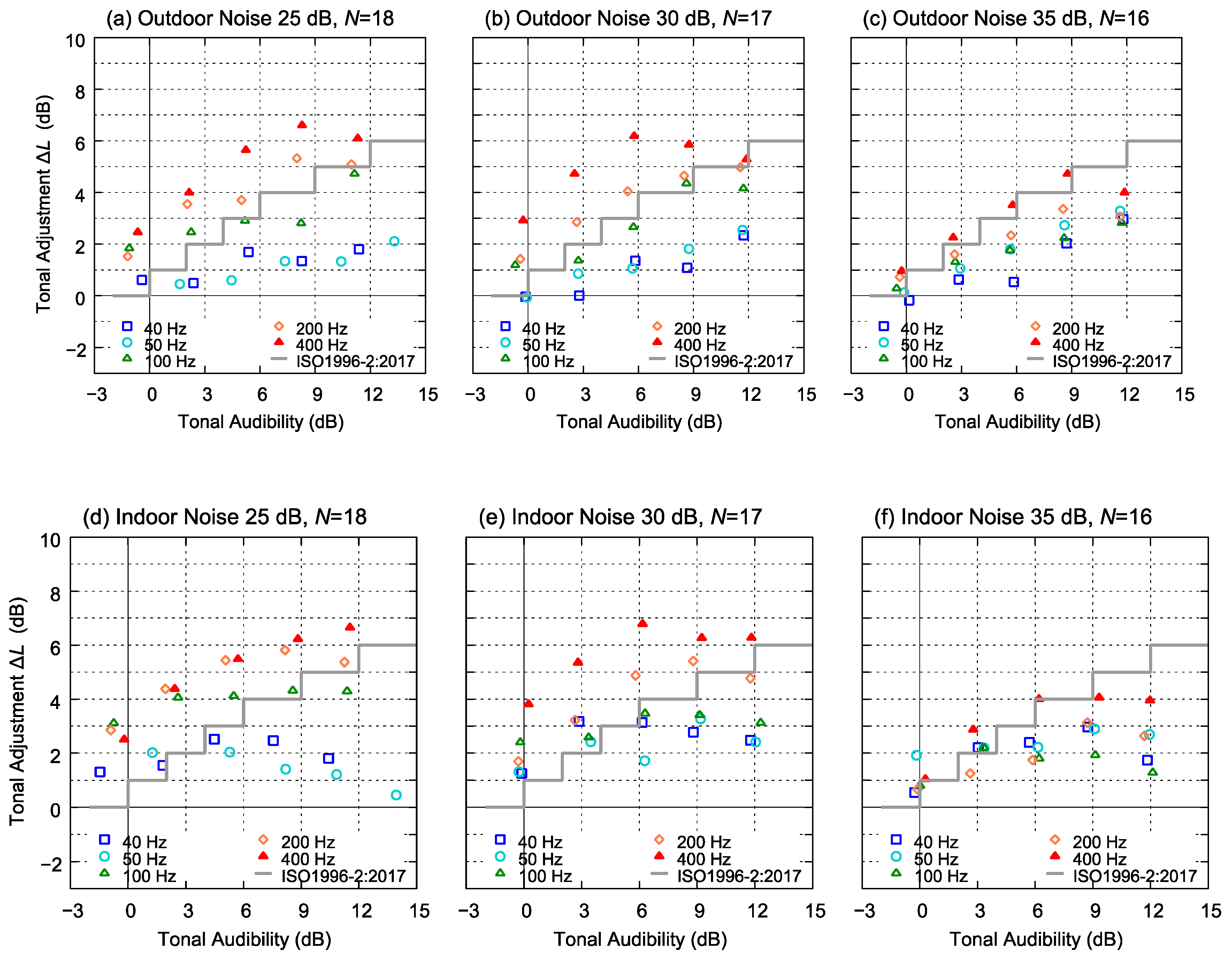
| 40 Hz | 50 Hz | 63 Hz | 80 Hz | 100 Hz | 125 Hz | 160 Hz | 200 Hz | |
|---|---|---|---|---|---|---|---|---|
| T30 (s) | 0.30 | 0.27 | 0.25 | 0.38 | 0.11 | 0.14 | 0.10 | 0.15 |
| (–) | 0.52 | 0.57 | 0.63 | 0.41 | 1.35 | 1.07 | 1.60 | 1.02 |
| Group | Assumed Situation | Type of Test Sound | Background Broadband Noise | Tonal Frequency | Tonal Audibility | Number of Test Sound per Subject | |
|---|---|---|---|---|---|---|---|
| Spectrum | LpA | ||||||
| Group A | Trying to sleep at home | Tonal | indoor/outdoor | 25 dB | 40, 50, 100, 200, 400 Hz | 0, 3, 6, 9, 12 dB | 50 + 8 |
| Reference | indoor/outdoor | 20, 25, 30, 35 dB | - | - | |||
| Group B | Trying to sleep at home | Tonal | indoor/outdoor | 30 dB | 40, 50, 100, 200, 400 Hz | 0, 3, 6, 9, 12 dB | 50 + 8 |
| Reference | indoor/outdoor | 25, 30, 35, 40 dB | - | - | |||
| Group C | Relaxing in the living room | Tonal | indoor/outdoor | 35 dB | 40, 50, 100, 200, 400 Hz | 0, 3, 6, 9, 12 dB | 50 +8 |
| Reference | indoor/outdoor | 30, 35, 40, 45 dB | - | - | |||
Publisher’s Note: MDPI stays neutral with regard to jurisdictional claims in published maps and institutional affiliations. |
© 2021 by the authors. Licensee MDPI, Basel, Switzerland. This article is an open access article distributed under the terms and conditions of the Creative Commons Attribution (CC BY) license (https://creativecommons.org/licenses/by/4.0/).
Share and Cite
Yonemura, M.; Lee, H.; Sakamoto, S. Subjective Evaluation on the Annoyance of Environmental Noise Containing Low-Frequency Tonal Components. Int. J. Environ. Res. Public Health 2021, 18, 7127. https://doi.org/10.3390/ijerph18137127
Yonemura M, Lee H, Sakamoto S. Subjective Evaluation on the Annoyance of Environmental Noise Containing Low-Frequency Tonal Components. International Journal of Environmental Research and Public Health. 2021; 18(13):7127. https://doi.org/10.3390/ijerph18137127
Chicago/Turabian StyleYonemura, Miki, Hyojin Lee, and Shinichi Sakamoto. 2021. "Subjective Evaluation on the Annoyance of Environmental Noise Containing Low-Frequency Tonal Components" International Journal of Environmental Research and Public Health 18, no. 13: 7127. https://doi.org/10.3390/ijerph18137127
APA StyleYonemura, M., Lee, H., & Sakamoto, S. (2021). Subjective Evaluation on the Annoyance of Environmental Noise Containing Low-Frequency Tonal Components. International Journal of Environmental Research and Public Health, 18(13), 7127. https://doi.org/10.3390/ijerph18137127






